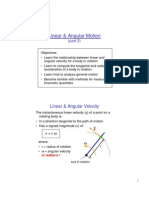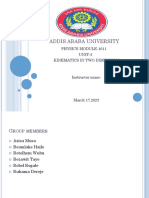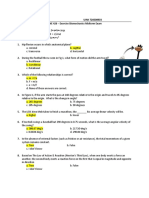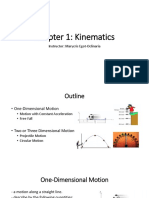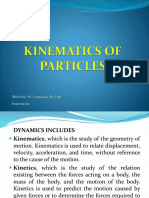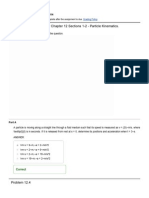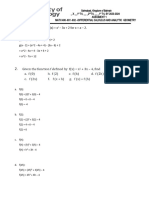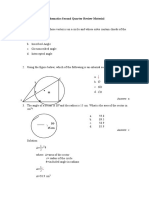2020-05-11
HH/KINE 3030 3.0
Biomechanics of Human
Movement
Angular vs. Linear
Kinematics Relationships
Chapter 11, Hall
© 2007 McGraw-Hill Higher Education. All rights reserved.
1
� 2020-05-11
Objectives
Explain the relationship between angular and
linear displacement, angular and linear
velocity, and angular and linear acceleration
Solve quantitative problems involving angular
kinematic quantities and the relationship
between and linear quantities
2
� 2020-05-11
Linear vs. Angular Motion
Although every part of an object moving about
an axis has the same angular distance, each
part of the object has a different linear
distance.
s2
s = r
2 2
s1
s = the linear distance (m) 1 1
r = radius between axis, point (m) r2
Φ = angular distance (rad) r1
3
� 2020-05-11
Linear vs. Angular Motion
Linear vs. Angular Velocity
Similar to relationship between linear and
angular distance:
v = r
•v = linear (tangential) velocity (m/s)
•r = radius between axis, point (m)
• ω = angular velocity (rad/s)
•In baseball batting, where would you want the ball and
bat to make contact? Why?
•To make a long shot in golf, what type of golf club
would be the best choice (long, short)? Why?
4
4
� 2020-05-11
Linear vs. Angular Motion
Linear vs. Angular Acceleration
The acceleration of a body in angular
motion can be resolved into two at
perpendicular linear acceleration
components
•Tangential Acceleration (at)
•Radial Acceleration (ar) ar
5
� 2020-05-11
Linear vs. Angular Motion
Tangential Acceleration
What is tangential acceleration?
• component of acceleration of at
angular motion directed
along a tangent to the
path of motion
• represents change in linear
speed
v2 - v1
• at = t = r
6
6
� 2020-05-11
Linear vs. Angular Motion
Radial Acceleration
What is radial acceleration?
• component of acceleration
of angular motion
directed toward the ar
center of curvature
• represents change in
direction
v2
• ar = r = r2
7
7
� 2020-05-11
Solving the Problem
Who is moving at the
fastest angular
velocity?
Who is moving at the
fastest linear velocity?
8
� 2020-05-11
Sample Problem A
Two baseballs are hit consecutively by
a bat. The angular velocity of the bat
was 30 rad/s in both cases. The first ball
was hit 20 cm from the axis. The
second ball was hit 40 cm from the axis.
What was the linear velocity of the bat
at the two contact points?
9
� 2020-05-11
Sample Problem A
Two baseballs are hit consecutively by a bat. The angular
velocity of the bat was 30 rad/s in both cases. The first ball was
hit 20 cm from the axis. The second ball was hit 40 cm from the
axis. What was the linear velocity of the bat at the two contact
points?
Known: Unknown:
=30 rad/s Vball1
rball1=0.2 m vball2
rball2=0.4 m
10
10
� 2020-05-11
Sample Problem A
Two baseballs are hit consecutively by a bat. The angular
velocity of the bat was 30 rad/s in both cases. The first ball was
hit 20 cm from the axis. The second ball was hit 40 cm from the
axis. What was the linear velocity of the bat at the two contact
points?
v=r
For Ball 1 For Ball 2
Vball1=(0.20 m)(30 rad/s) Vball2=(0.40 m)(30 rad/s)
=6 m/s =12 m/s
11
11
� 2020-05-11
Sample Problem B
Windmill style softball pitcher executes a pitch in 0.65
s. Their pitching arm is 0.7m long. Tangential ball
speed was 20 m/s just before release.
What are the magnitudes of the tangential and radial
accelerations of the ball just before release?
What is the magnitude of the total acceleration of the
ball just before release?
12
12
� 2020-05-11
Sample Problem B
Windmill style softball pitcher executes a pitch in 0.65 s. Their pitching
arm is 0.7m long. Tangential ball speed was 20 m/s just before
release.
What are the magnitudes of the tangential and radial accelerations of
the ball just before release?
Known: Unknown:
r= 0.7m at
t=0.65 s ar
v2= 20 m/s (at release) a
v1=0 m/s (at start of pitch)
13
13
� 2020-05-11
Sample Problem B
Windmill style softball pitcher executes a pitch in 0.65 s. Their pitching
arm is 0.7m long. Tangential ball speed was 20 m/s just before
release.
What are the magnitudes of the tangential and radial accelerations of
the ball just before release?
v2 v1 v22
at ar
t r
20 m s 0 (20 m s ) 2
0.65s 0.7m
30.8 m s 2 571.4 m s 2
14
14
� 2020-05-11
Sample Problem B
Windmill style softball pitcher executes a pitch in 0.65 s.
Their pitching arm is 0.7m long. Tangential ball speed was
20 m/s just before release.
What is the magnitude of the total acceleration of the ball
just before release?
a ar2 at2
a (571.4 m s 2 ) 2 (30.8 m s 2 ) 2
572.2 m s 2
15
15

